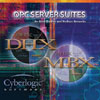
Automation Software: A logical choice
April 28, 2005
By
Jeremy Pollard
Collecting data from hardware devices on a plant floor used to be difficult. After years of device-driver growing pains, the Ole for Process Control (OPC) device communication specification was born. The specification, which provides a common interface for programmatic data access between hardware and software, allows automation software users to interface with any piece of control hardware with an OPC-compliant device driver.
The OPC server sits between a software application and a plant-floor device, and “serves up” data from the device to the application. Rockwell Automation developed its own communication servers for its Allen-Bradley devices and networks. Siemens, Wonderware and Intellution licensed their communication software from Cyberlogic Software Inc., a Troy, Mich.-based OEM software development firm. Schneider Electric private-labelled Cyberlogic’s suite of device drivers as the industry standard for Modicon networks. Schneider has been shipping the MBX Driver Suite with its network adapters for more than a decade.
Cyberlogic’s OPC servers support Modicon’s Modbus/Modbus Plus/Modbus TCP protocols, as well as all Rockwell’s communication protocols.
The server software installs nicely, even without the quick-start guide, which was missing from my copy. I found the help system useful. You have to install the OPC server and device drivers or agents, such as Data Hiway Plus or Ethernet, at the same time. The software suite is run-time protected, which is not uncommon with automation software. I was a little surprised that there were no “wizards” (software applications that lead you through configurations). So back to the help file I went.
I had a Modicon Modbus (Modbus TCP) slave device, a Rockwell Micrologix PLC (serial connection), and a Rockwell PLC-5 (Data Hiway Plus and Ethernet). This required that I configure one Modbus agent and three Rockwell/Allen Bradley agents.
Configuration was easy. The Cyberlogic device agents are virtual drivers so you simply apply the device connectivity, which determines the protocol the agent will use to communicate with the device. Once you configure the agents to communicate with the physical devices, the OPC server needs to know about them to be able to “serve them up” to your application. When you right-click with your mouse, it leads you to a menu with an “auto-configure” selection, which automatically finds the configured agents and devices. Naturally, the data available is dependent on the device. The configuration screen for the server shows you the connected device agents. Clicking on one of them reveals a “maximum concurrent request” (MCR) number. This allows you to throttle the device connection to minimize the resources required to maintain the connection. The driver agents support unsolicited messaging to minimize polling activities, which can reduce traffic by more than 90 percent. Once configuration is complete, Cyberlogic stores the resulting data in a Microsoft Access database.
Since the OPC server conforms to OPC standards, you can access the data in these devices using any OPC-compliant software package from companies such as Iconics, Rockwell Automation, Schneider Electric and Microsoft.
In my opinion, Cyberlogic’s way of using the resources available to it is unique. The software can access data from any connected device, regardless of the application. On a single form in Visual Basic, you can display data from all three devices using any combination of the four agents. When you have two connections to the same data point, the server will use the highest priority communication route available. Should connectivity to the primary route fail, the server employs the secondary route. When the highest priority connection returns, the server re-establishes connectivity. Access to data is intuitive using the built-in interface, so you can view data without having a third-party application.
A neat backroom technology of the software is it monitors communications between devices and the server, and automatically meters data requests should loading get too high for the PLC or the server. It is a smart and very useful technology in a slow network environment.
This OPC server suite is the real deal. I wrote a small Visual Basic program to access data from the PLC-5 from both the Data Hiway Plus driver and the Ethernet driver. I populated the form with timer data. Read times and form-update times were so similar that the numbers changed at the same time. The minimum update time from a timer is 10 milliseconds. This was “real time” enough for me.
The software does not support Rockwell’s pass-through connectivity. Upon checking with the company, I learned that it is not a highly requested feature. The OPC server suite does support Control Logix networking pass-through however.
Knowing Cyberlogic’s company history, I expected great things and wasn’t disappointed. For Modicon (Schneider Electric) and Rockwell applications, I highly recommend these OPC servers.
Jeremy Pollard can be reached at jpollard@tsuonline.com.
 PRODUCT SPECS:
PRODUCT SPECS:
Name: Cyberlogic OPC Server Suite
Version: 5.0
Vendor: Cyberlogic Software, Inc.
Application: Data acquisition and control
Price: US$750